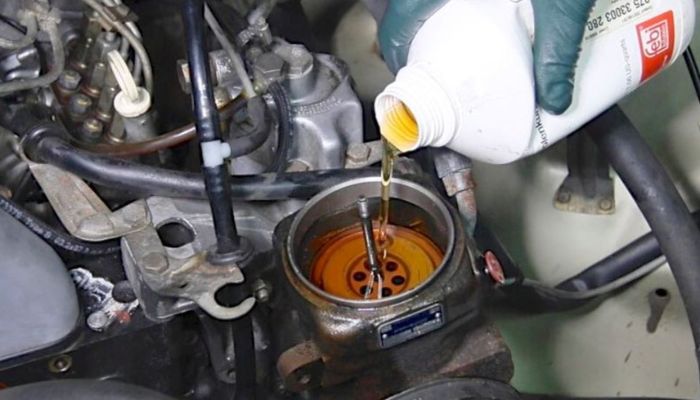Table of Contents
I recently learned about the importance of using the right power steering fluid for my Dodge Cummins truck. I used to think any fluid would work, but I found out that using Chrysler MS-1285 is crucial for keeping my steering smooth and responsive.
I learned that using the right power steering fluid is essential for my Dodge Cummins truck. The recommended fluid is Chrysler MS-1285, and checking the level regularly helps keep the steering smooth.
In this article, you’ll discover why using the right power steering fluid is crucial for keeping your Dodge Cummins truck running smoothly.
What is the recommended power steering fluid for Dodge Cummins trucks?
The recommended power steering fluid for Dodge Cummins trucks is typically Chrysler MS-1285. This specific fluid is formulated to meet the unique requirements of these vehicles, ensuring the best performance and longevity of the power steering system.
Power steering fluid is essential for providing the hydraulic pressure needed to assist in steering, allowing for smooth turns and effortless maneuvering. When using the correct fluid, you can help maintain the health of your power steering pump, seals, and hoses, preventing leaks and inefficient operation.
Can I use regular power steering fluid in my Dodge Cummins?
While regular power steering fluid might seem like a convenient choice, it’s crucial to avoid using it in your Dodge Cummins truck unless it explicitly states compatibility with Chrysler MS-1285. Generic or non-specific power steering fluids often contain different additives.
Using the wrong type of fluid can lead to harmful reactions between the fluid and the internal components, such as seals and gaskets. This could cause the seals to degrade, leading to leaks and loss of steering assistance.
How often should I change my power steering fluid – Avoid Costly Repairs!

Changing your power steering fluid regularly is essential for maintaining a healthy steering system in your Dodge Cummins truck. Generally, most manufacturers recommend checking the fluid level at every oil change, typically every 5,000 to 7,500 miles.
However, a full fluid change is often recommended every 2 to 3 years or every 50,000 to 100,000 miles, depending on driving conditions and usage. For instance, if you use your truck for heavy towing or in harsh conditions, more frequent changes might be necessary.
What symptoms indicate that I need to replace my power steering fluid?
- Steering Difficulty: If you find it hard to turn the steering wheel, it may mean the power steering fluid is low or dirty.
- Strange Noises: Unusual sounds like whining or squealing when you turn the wheel can signal that the fluid needs changing.
- Fluid Color Change: Healthy power steering fluid is usually clear or light pink. If it looks dark or brown, it’s time to replace it.
- Leak Under the Vehicle: If you notice puddles of fluid under your car, it might mean there’s a leak in the power steering system, requiring fluid replacement.
- Vibrations When Turning: Feeling vibrations or shaking when you turn can mean the fluid is low and needs to be topped up.
- Burning Smell: A burnt smell coming from the engine area can indicate that the power steering fluid is overheated or degraded.
- Steering Wheel Stiffness: If the steering wheel feels stiff or unresponsive, it can be due to old or low power steering fluid.
- Delayed Response: If there’s a noticeable delay when you turn the wheel, it may be time to check the fluid level and quality.
How do I check the power steering fluid level – Know Your Fluid Type!
Checking the power steering fluid level in your Dodge Cummins truck is a straightforward task that should ideally be done regularly as part of your routine maintenance. First, ensure your vehicle is parked on a level surface and the engine is off to get an accurate reading.
Open the hood and locate the power steering fluid reservoir; it is usually clearly marked with a symbol that resembles a steering wheel. Remove the cap from the reservoir to access the fluid. Many reservoirs come equipped with a dipstick attached to the cap, which allows you to check the fluid level without removing the entire top.
What Are The Effects of Mixing Power Steering Fluids?
Mixing different types of power steering fluids can lead to several problems that degrade the performance of your steering system. Each fluid is formulated with unique additives and properties designed for specific systems; therefore, mixing them can create chemical reactions that compromise their effectiveness.
One of the most common issues is foaming or aeration, which can result from incompatible additives interacting with each other. Foamy fluid can’t produce the necessary hydraulic pressure, making steering difficult and unresponsive.
Is it necessary to flush the power steering system- Steering Safety First!

Flushing the power steering system is not always necessary; however, it can be beneficial under certain circumstances. If you’ve regularly maintained your fluid and the system appears clean, a simple top-off may suffice.
However, if you notice symptoms such as unusual noises, difficulty steering, or discolored fluid, a flush is advised. Sometimes, contaminants can build up in the system over time, and simply adding new fluid won’t eliminate them.
How much power steering fluid do I need when changing it?
The amount of power steering fluid you’ll need for your Dodge Cummins truck can vary, but generally, you can expect to use between 1 to 2 quarts. The exact amount depends on your vehicle’s model year and the extent of the fluid change.
Always refer to your owner’s manual for the specific fluid capacity for your model. When preparing for a fluid change, gather the appropriate fluid, which should meet Chrysler MS-1285 specifications, along with tools for accessing the reservoir.
What are the dangers of using the wrong power steering fluid?
Steering System Damage:
Using the wrong power steering fluid can harm the internal components of your steering system. Different fluids have varying chemical properties, and using the incorrect one can lead to corrosion or wear.
Increased Steering Difficulties:
If the power steering fluid isn’t suitable, you may notice difficulty in turning the wheel. The fluid needs to provide the right amount of lubrication and pressure. The wrong fluid can result in stiff steering, making it harder to maneuver your vehicle.
Overheating:
Using the wrong power steering fluid can cause the system to overheat. This can happen if the fluid is not able to handle high temperatures, leading to a breakdown of the fluid. Overheated fluid can create air bubbles, reducing its effectiveness.
Noise and Vibration:
Incorrect fluid can lead to increases in noise and vibration when steering. You may hear whining or grinding sounds while turning the wheel. This can be a sign that your power steering system is struggling and could eventually fail.
Fluid Leaks:
Some fluids may not be compatible with the seals in your steering system, causing them to break down and leak. Fluid leaks can lead to low fluid levels, which means your power steering won’t work efficiently, making your vehicle harder to control.
Can low power steering fluid cause steering problems?
Yes, low power steering fluid can lead to significant steering problems in your Dodge Cummins truck. The power steering fluid acts as hydraulic fluid that helps facilitate steering by providing the required pressure to the steering mechanism.
If the fluid level drops too low, the power steering pump may struggle to generate enough pressure, resulting in heavy steering or resistance when turning the wheel. You might notice that it takes more effort to steer, or you may feel a delay in your steering response.
How do I add power steering fluid to my Dodge Cummins?

Adding power steering fluid to your Dodge Cummins truck is a relatively simple task that you can perform yourself. To begin, park your vehicle on a level surface and turn off the engine to ensure your safety while working.
Open the hood and locate the power steering fluid reservoir; it’s typically marked with a steering wheel icon. Remove the cap carefully, and if there’s a dipstick attached, wipe it clean and reinsert it to check the fluid level.
Are there any alternatives to Chrysler MS-1285?
While it is best to use the manufacturer-recommended Chrysler MS-1285 power steering fluid for your Dodge Cummins truck, some alternatives may be available that are specifically labeled as compatible with this specification.
Some third-party brands might produce fluids that claim compatibility, but not all fluids are created equally, and using a non-approved fluid can lead to several problems, including poor performance and the potential for system damage.
Frequently Asked Questions:
Can I use ATF as power steering fluid?
While some vehicles use Automatic Transmission Fluid (ATF) in their power steering systems, it is not recommended for Dodge Cummins trucks unless specifically stated in the owner’s manual.
What to do if there’s a power steering leak?
If you notice a leak in your power steering system, it’s vital to address the issue as soon as possible to prevent further damage. First, check the power steering fluid reservoir to see if the fluid level is low.
Can I flush my power steering system myself?
Yes, you can flush your power steering system yourself, but it requires attention to detail and some mechanical knowledge. Flushing the system involves removing old, dirty fluid and replacing it with fresh fluid, which can significantly improve the performance and lifespan of your power steering components.
What is the cost of power steering fluid?
The cost of power steering fluid can vary based on several factors such as brand, quality, and type. On average, you can expect to pay between $5 and $15 for a quart of power steering fluid.
Can power steering fluid affect fuel efficiency?
While power steering fluid itself does not directly affect fuel efficiency, the performance of the power steering system can have an indirect impact on your vehicle’s overall fuel economy. When the power steering system is functioning optimally.
In The End:
In conclusion, using the wrong power steering fluid can lead to serious problems for your vehicle. It can damage the steering system, make steering difficult, and even cause leaks. These issues can result in expensive repairs and increased maintenance costs.


